
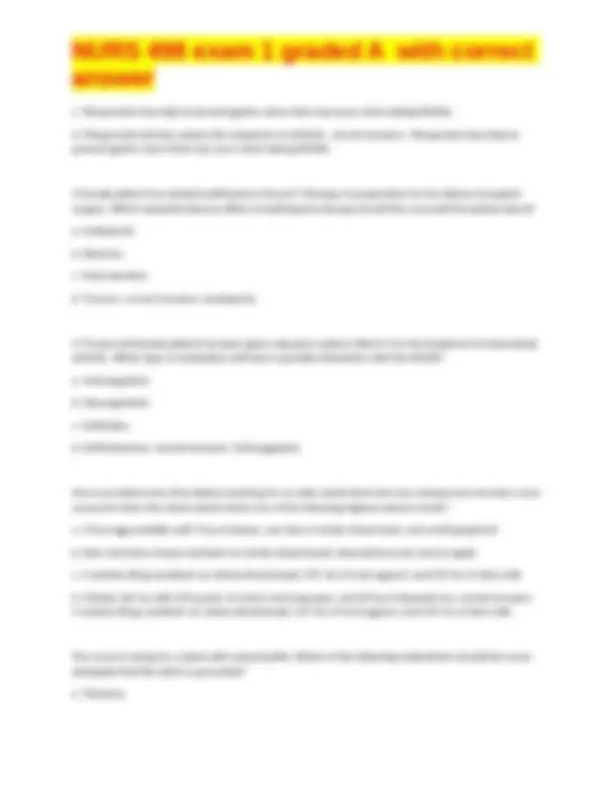
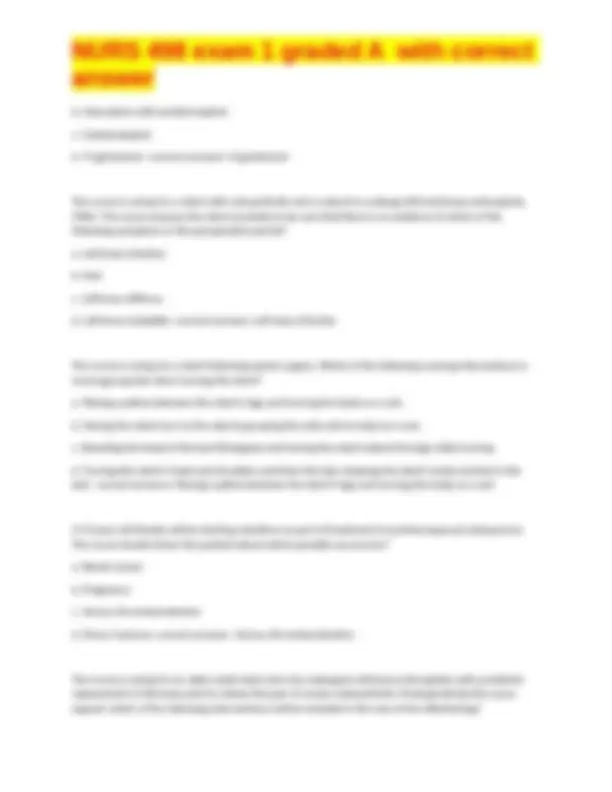
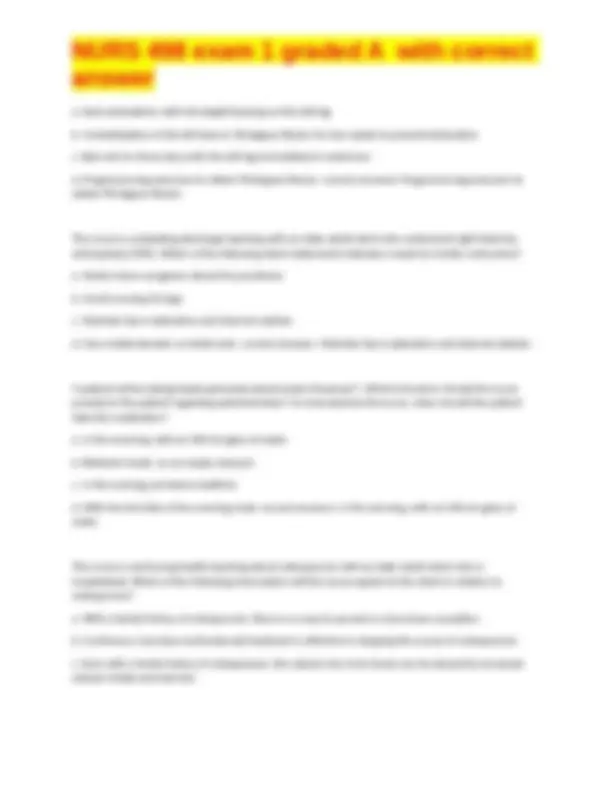
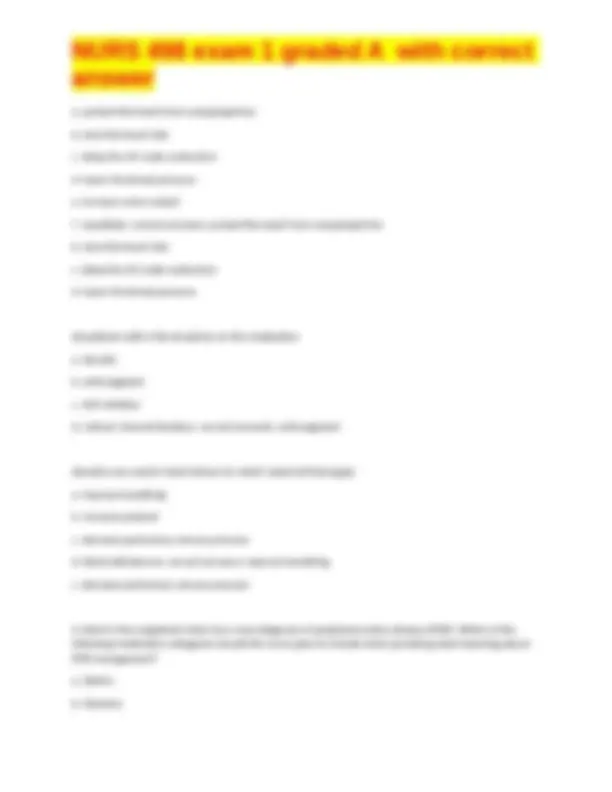
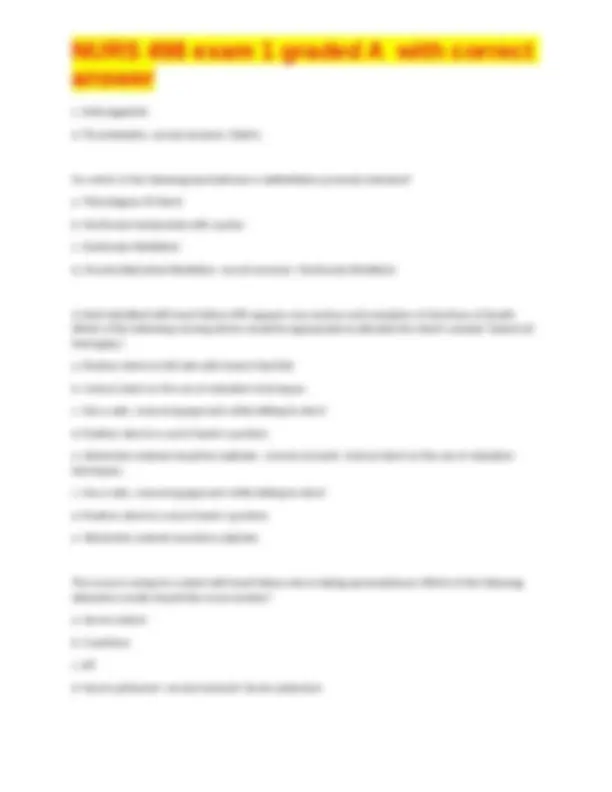
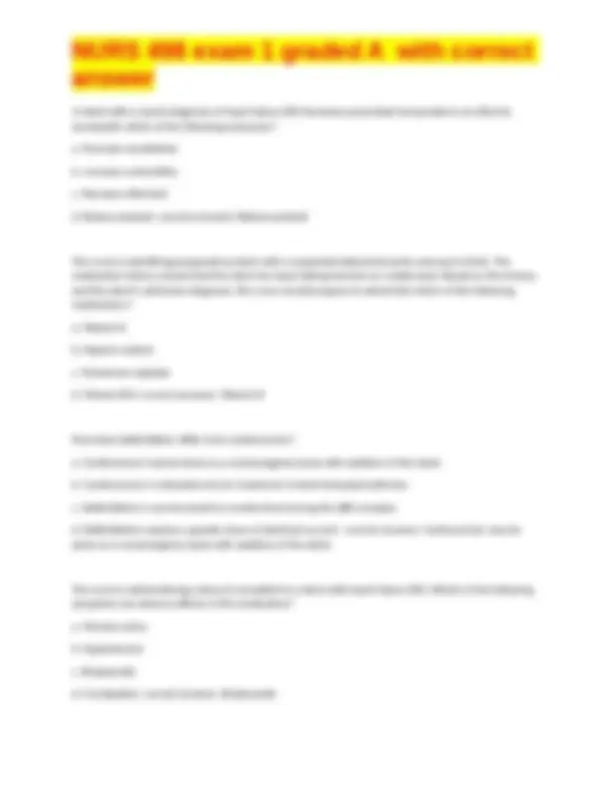
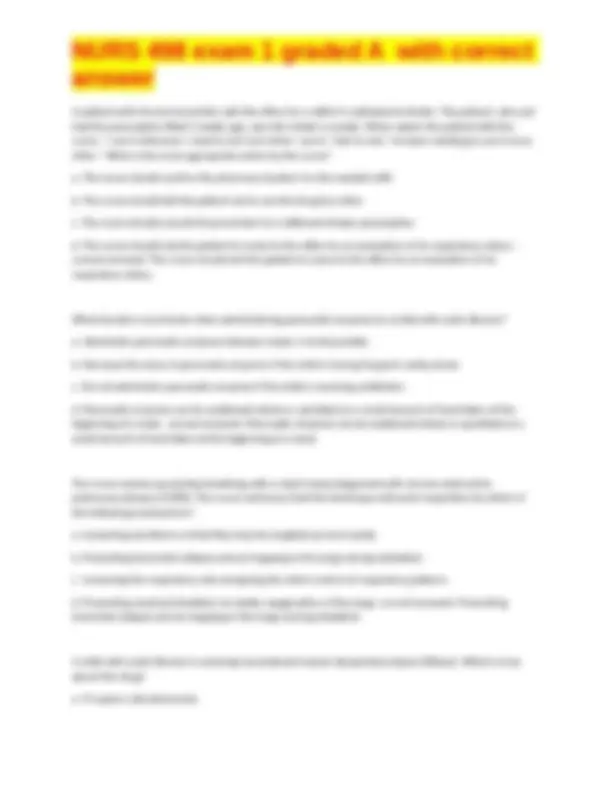
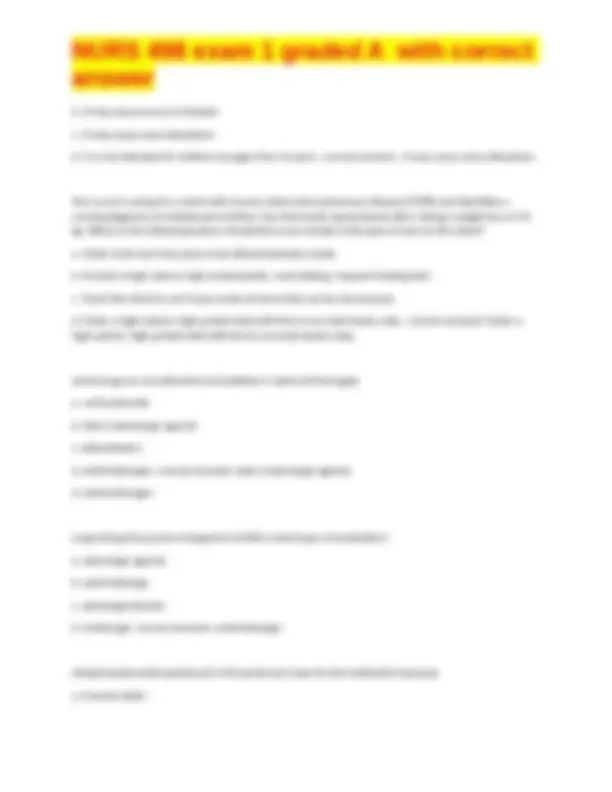
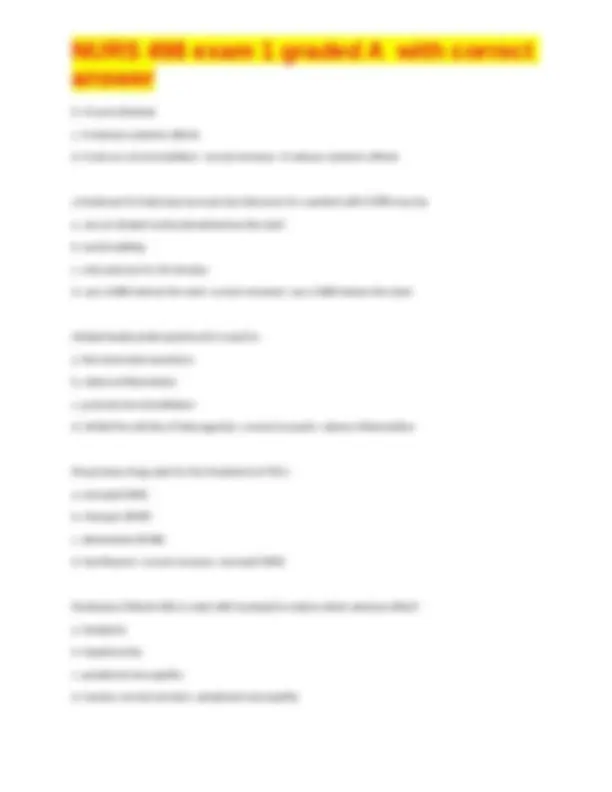
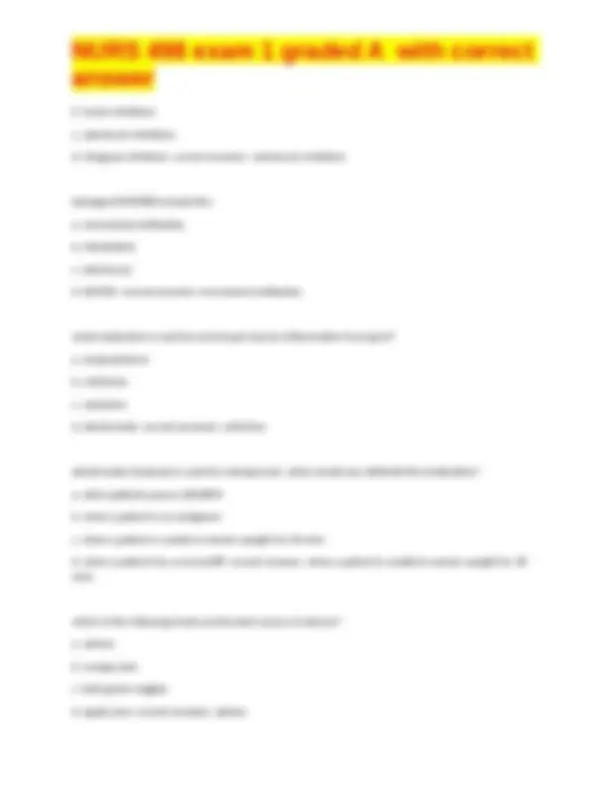
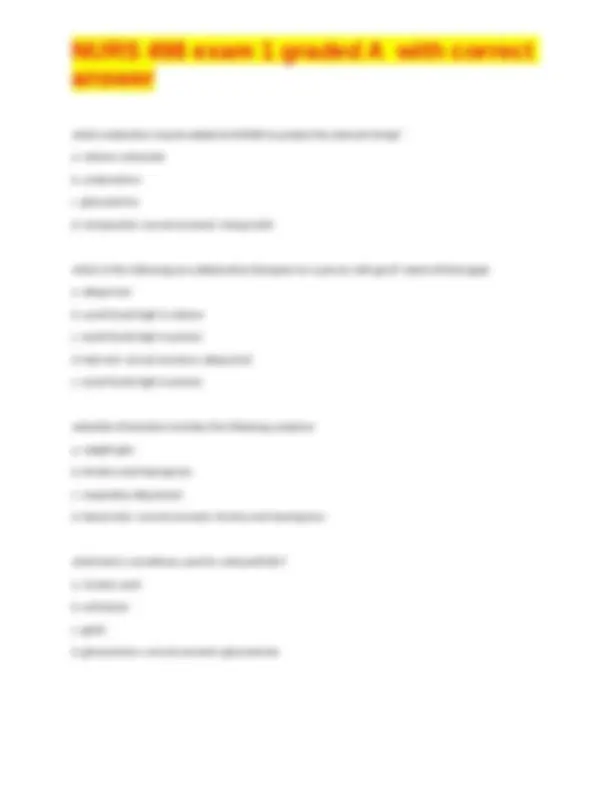


Study with the several resources on Docsity

Earn points by helping other students or get them with a premium plan


Prepare for your exams
Study with the several resources on Docsity

Earn points to download
Earn points by helping other students or get them with a premium plan
Community
Ask the community for help and clear up your study doubts
Discover the best universities in your country according to Docsity users
Free resources
Download our free guides on studying techniques, anxiety management strategies, and thesis advice from Docsity tutors
NURS 498 exam 1 graded A with correct answerNURS 498 exam 1 graded A with correct answer
Typology: Exams
1 / 19

This page cannot be seen from the preview
Don't miss anything!












A patient with acquired immune deficiency syndrome (AIDS) has been taking zidovudine (AZT) therapy for almost 1 year. The physician has decided to change the medication to a new ART called didanosine (Videx EC®). The patient is very concerned about this medication change. What is the nurse's best explanation to the patient? a. Taking the zidovudine with the didanosine might have led to serious toxicity. b. The patient may have been experiencing bone marrow suppression due to the zidovudine therapy. c. Didanosine has been shown to improve survival rates. d. Didanosine has fewer toxic effects than zidovudine. -correct answerb. The patient may have been experiencing bone marrow suppression due to the zidovudine therapy. A patient with active HIV has been taking zidovudine (Retrovir®). Which potential adverse effect may limit the length of time this medication can be taken? A. Bone marrow suppression B. lactic acidosis C. hepatomegaly D. fatigue -correct answerA. Bone marrow suppression Before administering methotrexate to a patient, what is most important for the nurse to assess? A. Latent tuberculosis B. Allergy to eggs C. Congestive heart failure D. hypothyroidism -correct answerA. Latent tuberculosis The nurse is teaching a client on immunosuppressant therapy after a kidney transplant about the post- transplant drug regimen. Which of the following statements by the client should alert the nurse that additional teaching is required? a. "After a couple of years, it is likely that I will be able to stop taking the calcineurin inhibitor." b. "The drugs are given in combination because they inhibit different aspects of transplant rejection." c. "I need to be monitored closely because I have a greater chance of developing malignant tumours."
d. "If I develop an acute rejection episode, I will need to have other types of drugs given IV." -correct answera. "After a couple of years, it is likely that I will be able to stop taking the calcineurin inhibitor." Which potential problem is of most concern for a patient receiving immunosuppressant drugs? A. Increased susceptibility to infections B. Orthostatic hypotension C. Neurotoxicity D. Confusion -correct answerA. Increased susceptibility to infections Which medication is indicated in the treatment of rheumatoid arthritis? a. tretinoin (Vesanoid®) b. bacillus Calmette-Guérin (BCG) vaccine (Immuncyst®) c. thalidomide (Thalomid®) d. etanercept (Enbrel®) -correct answerd. etanercept (Enbrel®) When providing patient education related to immunosuppressive therapy, which items of information will the nurse include? a. If a dose is missed, double the next scheduled dose. b. If the blister-pack pills have an odour, discard them. c. It is important to have a 1-week supply of medication. d. Take the medication with any type of juice or water. -correct answerc. It is important to have a 1- week supply of medication. A patient has used buffered acetylsalicylic acid (Aspirin) for several years as treatment for osteoarthritis. However, the patient's symptoms are worsening, and now something stronger is needed. The physician prescribes an NSAID and misoprostol. The patient asks the nurse why two pills now have to be taken for the arthritis. Which is the nurse's best response to the patient? a. Misoprostol reduces the mucous secretions in the stomach, which reduces gastric irritation. b. Misoprostol potentiates the action of the NSAID so that it will work better.
b. Oxycodone with acetaminophen c. Carbamazepine d. IV gentamicin -correct answerd. IV gentamicin The nurse is caring for a client with osteoarthritis who is about to undergo left total knee arthroplasty (TKA). The nurse assesses the client carefully to be sure that there is no evidence of which of the following symptoms in the preoperative period? a. Left knee infection b. Pain c. Left knee stiffness d. Left knee instability -correct answera. Left knee infection The nurse is caring for a client following spinal surgery. Which of the following nursing interventions is most appropriate when turning the client? a. Placing a pillow between the client's legs and turning the body as a unit. b. Having the client turn to the side by grasping the side rails to help turn over. c. Elevating the head of the bed 30 degrees and having the client extend the legs while turning. d. Turning the client's head and shoulders and then the hips, keeping the client's body centred in the bed. -correct answera. Placing a pillow between the client's legs and turning the body as a unit. A 51-year-old female will be starting raloxifene as part of treatment of postmenopausal osteoporosis. The nurse should inform this patient about which possible occurrence? a. Breast cancer b. Pregnancy c. Venous thromboembolism d. Stress fractures -correct answerc. Venous thromboembolism The nurse is caring for an older-adult client who has undergone left knee arthroplasty with prosthetic replacement of the knee joint to relieve the pain of severe osteoarthritis. Postoperatively the nurse expects which of the following interventions will be included in the care of the affected leg?
a. Early ambulation with full weight bearing on the left leg b. Immobilization of the left knee in 30-degree flexion for two weeks to prevent dislocation c. Bed rest for three days with the left leg immobilized in extension d. Progressive leg exercises to obtain 90-degree flexion -correct answerd. Progressive leg exercises to obtain 90-degree flexion The nurse is completing discharge teaching with an older-adult client who underwent right total hip arthroplasty (THA). Which of the following client statements indicates a need for further instruction? a. Notify future caregivers about the prosthesis. b. Avoid crossing his legs. c. Maintain hip in adduction and internal rotation. d. Use a toilet elevator on toilet seat. -correct answerc. Maintain hip in adduction and internal rotation. A patient will be taking bisphosphonate alendronate (Fosamax®). What instruction should the nurse provide to the patient regarding administration? As instructed by the nurse, when should the patient take this medication? a. In the morning, with an 240-mL glass of water b. Between meals, on an empty stomach c. In the evening just before bedtime d. With the first bite of the morning meal -correct answera. In the morning, with an 240-mL glass of water The nurse is reinforcing health teaching about osteoporosis with an older-adult client who is hospitalized. Which of the following information will the nurse explain to the client in relation to osteoporosis? a. With a family history of osteoporosis, there is no way to prevent or slow bone resorption. b. Continuous, low-dose corticosteroid treatment is effective in stopping the course of osteoporosis. c. Even with a family history of osteoporosis, the calcium loss from bones can be slowed by increased calcium intake and exercise.
d. increased electrical impulses of the heart -correct answerb. increased force of the heart contraction what may put a patient at risk of digoxin toxicity? a. hypokalemia b. hyperkalemia c. hyponatremia d. hypocalcemia -correct answera. hypokalemia what does negative chronotropic effect mean? a. increased heart rate b. decreased heart rate c. decreased conduction d. increased blood pressure -correct answerb. decreased heart rate what is the reason an ACE inhibitor may be used for a patient in heart failure? a. decrease preload b. increase vasoconstriction c. slow the heart rate d. decrease cardiac output -correct answera. decrease preload ARBs are used to decrease systemic vascular resistance. this is also known as what? a. preload b. vasoconstriction c. blood pressure d. afterload -correct answerd. afterload beta blockers do what? select all that apply
a. protect the heart from norepinephrine b. slow the heart rate c. delay the AV node conduction d. lower the blood pressure e. increase urine output f. vasodilate -correct answera. protect the heart from norepinephrine b. slow the heart rate c. delay the AV node conduction d. lower the blood pressure all patients with A-fib should be on this medication a. diuretic b. anticoagulant c. ACE inhibitor d. calcium channel blockers -correct answerb. anticoagulant diuretics are used in heart failure for what? select all that apply a. improve breathing b. increase preload c. decrease pulmonary venous pressure d. block aldosterone -correct answera. improve breathing c. decrease pulmonary venous pressure A client in the outpatient clinic has a new diagnosis of peripheral artery disease (PAD). Which of the following medication categories should the nurse plan to include when providing client teaching about PAD management? a. Statins b. Vitamins
A client with a recent diagnosis of heart failure (HF) has been prescribed furosemide in an effort to accomplish which of the following outcomes? a. Promote vasodilation b. Increase contractility c. Decrease afterload d. Reduce preload -correct answerd. Reduce preload The nurse is admitting preoperative client with a suspected abdominal aortic aneurysm (AAA). The medication history reveals that the client has been taking warfarin on a daily basis. Based on this history and the client's admission diagnosis, the nurse should prepare to administer which of the following medications? a. Vitamin K b. Heparin sodium c. Protamine sulphate d. Vitamin B12 -correct answera. Vitamin K How does defibrillation differ from cardioversion? a. Cardioversion may be done on a nonemergency basis with sedation of the client. b. Cardioversion is indicated only for treatment of atrial tachydysrhythmias. c. Defibrillation is synchronized to countershock during the QRS complex. d. Defibrillation requires a greater dose of electrical current. -correct answera. Cardioversion may be done on a nonemergency basis with sedation of the client. The nurse is administering a dose of carvedilol to a client with heart failure (HF). Which of the following symptoms are adverse effects of this medication? a. Muscles aches b. Hypertension c. Bradycardia d. Constipation -correct answerc. Bradycardia
Which of the following interventions in the care of a client with a diagnosis of chronic venous insufficiency (CVI) is priority? a. Teaching the client the correct use of compression stockings b. Application of topical antibiotics to venous ulcers c. Administration of oral and subcutaneous anticoagulants (or both) d. Maintaining the client's legs in a dependent position -correct answera. Teaching the client the correct use of compression stockings A client with a diagnosis of heart failure (HF) has been started on a nitroglycerin patch by his primary care provider. Which of the following should the nurse teach the client to avoid? a. Over-the-counter H2-receptor blockers b. Drugs to treat erectile dysfunction c. High-potassium foods d. Nonsteroidal anti-inflammatory drugs (NSAIDs) -correct answerb. Drugs to treat erectile dysfunction The nurse is teaching a client how to self-administer ipratropium via a metered-dose inhaler. Which of the following instructions should the nurse provide to the client about proper inhalation technique? a. "Using a spacer should be avoided for this type of medication." b. "After taking a puff, hold the breath for 30 seconds before exhaling." c. "Avoid shaking the inhaler before use." d. "Breathe out slowly before positioning the inhaler." -correct answerd. "Breathe out slowly before positioning the inhaler." The nurse is caring for a client who is receiving oxygen per nasal cannula while hospitalized for chronic obstructive pulmonary disease (COPD). The client asks the nurse whether oxygen use will be needed at home. Which of the following responses is best? a. "Oxygen will not be needed until or unless you are in the terminal stages of this disease." b. "Long-term home oxygen therapy should be used to prevent heart problems related to COPD."
A patient with chronic bronchitis calls the office for a refill of a salbutamol inhaler. The patient, who just had the prescription filled 2 weeks ago, says the inhaler is empty. When asked, the patient tells the nurse, "I use it whenever I need it, but now when I use it, I feel so sick. I've been needing to use it more often." What is the most appropriate action by the nurse? a. The nurse should confirm the pharmacy location for the needed refill. b. The nurse should tell the patient not to use this drug too often. c. The nurse should consult the prescriber for a different inhaler prescription. d. The nurse should ask the patient to come to the office for an evaluation of his respiratory status. - correct answerd. The nurse should ask the patient to come to the office for an evaluation of his respiratory status. What should a nurse know when administering pancreatic enzymes to a child with cystic fibrosis? a. Administer pancreatic enzymes between meals, if at all possible. b. Decrease the dose of pancreatic enzymes if the child is having frequent, bulky stools. c. Do not administer pancreatic enzymes if the child is receiving antibiotics. d. Pancreatic enzymes can be swallowed whole or sprinkled on a small amount of food taken at the beginning of a meal. -correct answerd. Pancreatic enzymes can be swallowed whole or sprinkled on a small amount of food taken at the beginning of a meal. The nurse reviews pursed-lip breathing with a client newly diagnosed with chronic obstructive pulmonary disease (COPD). The nurse reinforces that this technique will assist respiration by which of the following mechanisms? a. Loosening secretions so that they may be coughed up more easily b. Preventing bronchial collapse and air trapping in the lungs during exhalation c. Increasing the respiratory rate and giving the client control of respiratory patterns d. Promoting maximal inhalation for better oxygenation of the lungs -correct answerb. Preventing bronchial collapse and air trapping in the lungs during exhalation A child with cystic fibrosis is receiving recombinant human deoxyribonuclease (DNase). Which is true about this drug? a. It is given subcutaneously.
b. It may cause mucus to thicken. c. It may cause voice alterations. d. It is not indicated for children younger than 12 years. -correct answerc. It may cause voice alterations. The nurse is caring for a client with chronic obstructive pulmonary disease (COPD) and identifies a nursing diagnosis of imbalanced nutrition: less than body requirements after noting a weight loss of 14 kg. Which of the following actions should the nurse include in the plan of care for this client? a. Order fruits and fruit juices to be offered between meals. b. Provide a high-calorie, high-carbohydrate, nonirritating, frequent feeding diet. c. Teach the client to use frozen meals at home that can be microwaved. d. Order a high-calorie, high-protein diet with five to six small meals a day. -correct answerd. Order a high-calorie, high-protein diet with five to six small meals a day. what drugs are considered bronchodilators? select all that apply a. corticosteroids b. beta 2 adrenergic agonist c. beta blockers d. anticholinergics -correct answerb. beta 2 adrenergic agonist d. anticholinergics Long-Acting Muscarinic Antagonist (LAMA) is what type of medication? a. adrenergic agonist b. anticholinergic c. adrenergic blocker d. cholinergic -correct answerb. anticholinergic inhaled budesonide (pulmicort) is the preferred route for this medication because: a. it works faster
rifampin used for TB can cause this side effect: a. orange urine and tears b. peripheral neuropathy c. black, hairy tongue d. growth retardation -correct answera. orange urine and tears a patient with active TB is admitted to your unit. what type of isolation do you use? a. contact b. droplet c. airborne d. no isolation -correct answerc. airborne teaching a patient about TB medications should include: select all that apply a. take the medications until the symptoms are gone b. take the medications at the same time every day c. you are contagious for all the time you are on the medication d. avoid alcohol e. report tingling of your fingers to your HCP f. use another form of birth control while on the medications -correct answerb. take the medications at the same time every day d. avoid alcohol f. use another form of birth control while on the medications corticosteroids have many actions, these include: select all that apply a. reduce release of interleukin- b. decrease migration of WBCs c. promote the production of glycogen in the liver
d. reduce the production of glycogen in the liver e. promote the redistribution of fat f. cause weight loss -correct answera. reduce release of interleukin- b. decrease migration of WBCs c. promote the production of glycogen in the liver e. promote the redistribution of fat which of the following is not a conventional disease modifying antirheumatic drug (DMARD)? a. methotrexate (rheumatrex) b. peginterferon alfa-2a c. hydroxychloroquine (plaquenil) d. azathioprine (Imuran) -correct answerb. peginterferon alfa-2a which antiretroviral medication is offered during pregnancy to an HIV positive woman? a. ritonavir (norvir) b. zidovudine (retrovir) c. emtricitabine (emtriva) d. cabenuva (cabotegravir/rilpivirine) -correct answerb. zidovudine (retrovir) a patient with RA is taking cyclosporine. what treatment should she avoid? a. ibuprophen b. corticosteroids c. varicella zoster vaccine d. adalimumab -correct answerc. varicella zoster vaccine which of the following class of medications is not an antiretroviral used for HIV? a. protease inhibitors
which medication may be added to NSAIDS to protect the stomach lining? a. calcium carbonate b. ondancetron c. glucosamine d. misoprostol -correct answerd. misoprostol which of the following are collaborative therapies for a person with gout? select all that apply a. allopurinol b. avoid foods high in calcium c. avoid foods high in purines d. bed rest -correct answera. allopurinol c. avoid foods high in purines salicylate intoxication includes the following symptom: a. weight gain b. tinnitus and hearing loss c. respiratory depression d. blood clots -correct answerb. tinnitus and hearing loss what herb is sometimes used for osteoarthritis? a. st johns wort b. echinacea c. garlic d. glucosamine -correct answerd. glucosamine